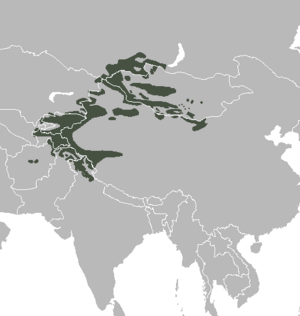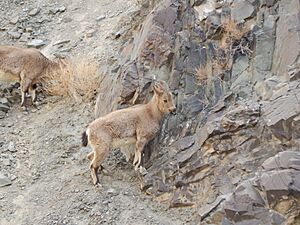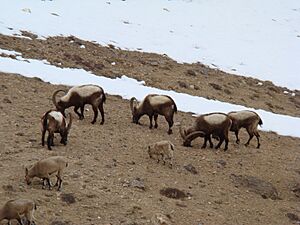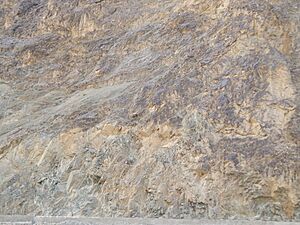Siberian ibex facts for kids
Quick facts for kids Siberian ibex |
|
|---|---|
 |
|
| Female and male at the Berlin Zoological Garden, Germany | |
| Conservation status | |
| Scientific classification | |
| Genus: |
Capra
|
| Species: |
sibirica
|
 |
|
| Range of the Siberian ibex | |
The Siberian ibex (Capra sibirica) is a large wild goat. It is also known by many other names like Altai ibex or Himalayan ibex. These names come from the different places it lives in Central Asia. The Siberian ibex is the most common type of ibex found across the world.
These amazing animals are related to both goats and sheep. They are the longest and heaviest members of the Capra family, which includes all ibex species. However, another animal called the markhor is a little taller at the shoulder.
Right now, the Siberian ibex is listed as Near Threatened. This means their numbers are slowly going down. This is mainly because of too much hunting, especially by wealthy hunters. Also, there aren't many of them in some areas. Scientists are still studying them to get more exact information.
Contents
What Do Siberian Ibex Look Like?
Siberian ibex are big, strong goats, but their size can change a lot. Male ibex are usually between 88 and 110 centimeters (about 35 to 43 inches) tall at the shoulder. They can weigh from 60 to 130 kilograms (about 132 to 287 pounds). Females are much smaller. They stand about 67 to 92 centimeters (about 26 to 36 inches) tall. Females weigh between 34 and 56 kilograms (about 75 to 123 pounds).
Both male and female ibex have beards. However, the male's beard is much bigger. Sometimes, females don't have a beard at all. Both sexes also have a special scent gland under their tail. It is about 3 centimeters (just over an inch) wide.
Female ibex have smaller horns. They are grey-brown and usually about 27 centimeters (about 11 inches) long. Fully grown male ibex have long, black horns. These horns are typically about 115 centimeters (about 45 inches) long. Some very old males can even have horns up to 148 centimeters (about 58 inches) long! Both sexes have rings on their horns that show how old they are. Males also have large bumps on the front of their horns. The exact shape of their horns can be different for each ibex.
Their fur color can vary a lot. It can be dark brown, light tan, or even reddish. They usually have a darker stripe down their back and tail. In winter, some males get dark patches on their backs that look like saddles. Their undersides are lighter in color. During winter, adult males become much darker with white patches. Females and young ibex are usually plainer in color than adult males. They might not have the stripe down their back. Siberian ibex shed their fur between April and July. They get a lighter summer coat. This coat grows longer and darker as the year goes on. By December, they have their full winter coat.

Types of Siberian Ibex
Some experts think there is only one type of Siberian ibex. However, others believe there are four different types, or subspecies. These types are mainly different in their size, horn size, and fur color.
- C. s. sibirica (Siberian or Altai Ibex) – found in the Sayan Mountains
- C. s. alaiana (Tian Shan Ibex) – found in the Alay Mountains
- C. s. hagenbecki (Gobi or Mongolian Ibex) – found in western Mongolia
- C. s. sakeen (Himalayan Ibex) – found in the Pamir Mountains, western Himalayas, India, Afghanistan, and Pakistan
Life Cycle of the Siberian Ibex
Siberian ibex usually mate from late October to early January. This time is called the rut. During the rut, male ibex spend a lot of time trying to attract females. They often become very thin because they don't eat much. Their courtship can last for over 30 minutes. Males also fight each other to show who is strongest. They stand on their back legs and crash their horns together.
A female ibex is pregnant for about 170 to 180 days. She usually gives birth to one baby, called a kid. Sometimes, she might have twins (up to 14% of births). Very rarely, triplets are born. Newborn kids weigh about 3 kilograms (about 6.6 pounds). They grow very quickly in their first year. Their horns start to show after about three to four weeks. Kids begin to eat grass when they are only eight days old. However, they don't eat it regularly until they are about one month old. They stop drinking their mother's milk completely when they are six months old.
Male ibex can have babies when they are about eighteen months old. But they don't reach their full adult size until they are nine years old. Females usually have their first babies when they are two years old. In the wild, males typically live for about ten years. Females can live longer, up to seventeen years. In zoos, they have been known to live for up to 22 years.
How Do Siberian Ibex Behave?
Siberian ibex usually live high up in the mountains. They are often found near or above the line where trees stop growing. In winter, they move to lower slopes to find food. On very hot days, they might go closer to the tree line. However, they do not go into thick forests. They prefer to return to their high mountain homes when it cools down. When there is a lot of snow, they use their hooves to dig through it to reach the plants underneath.
Their main food is mountain grasses and other plants. In spring and summer, they eat mostly grasses and sedges. In winter, they eat more tall plants, twigs, and needles from trees like aspen, spruce, juniper, and willow. In summer, they often visit places with natural salt. These are called salt licks.
The size of ibex groups changes depending on how many are in the area. A group of about 5 to 30 ibex is most common. But they can form much larger groups during the mating season. Outside of the mating season, most groups are made up of only males or only females. Some mixed groups of males and females stay together all year. Ibex spend most of the day eating grass. They stay in one spot for an hour or more before moving to a new place.
Male and female ibex act differently when choosing where to eat. They also differ in group size and how they protect themselves. When there is plenty of food, groups are larger because there is less competition. In winter, males and females eat similar foods. They also mix in groups more. But in summer, they eat different things and stay in separate groups. Female ibex focus on keeping their babies healthy and safe. So, they often stay near water sources. They also choose areas with the most nutritious plants. Females are also more watchful for predators.
The main animals that hunt Siberian ibex are Himalayan wolves, dholes (wild dogs), snow leopards, and brown bears. Young ibex can also be hunted by lynxes, foxes, and eagles.
Where Do Siberian Ibex Live?
Siberian ibex live mostly above the tree line. They prefer areas with steep slopes and rocky ground. Their home includes high-altitude grasslands, mountain meadows, and dry, desert-like regions. In the Gobi Desert, they can be found on hills as low as 700 meters (about 2,300 feet). But they are more often found between 2,000 and 5,000 meters (about 6,500 to 16,400 feet) in summer. In winter, they move down to lower slopes, sometimes with a few trees. In Tajikistan, where ibex live depends on things like temperature and rain.
Most Siberian ibex are found in central and northern Asia. This includes countries like Afghanistan, western and northern China (especially Xinjiang), north-western India, south-eastern Kazakhstan, Kyrgyzstan, Tajikistan, eastern Uzbekistan, Mongolia, northern Pakistan, and south-central Russia. In 1978, 40 Siberian ibex were brought to the Canadian River canyon in New Mexico, United States. A small group of them has grown there.
Special Mentions
The Ladakh Scouts regiment, which is part of the Indian Army, uses the ibex as its special animal or mascot.





